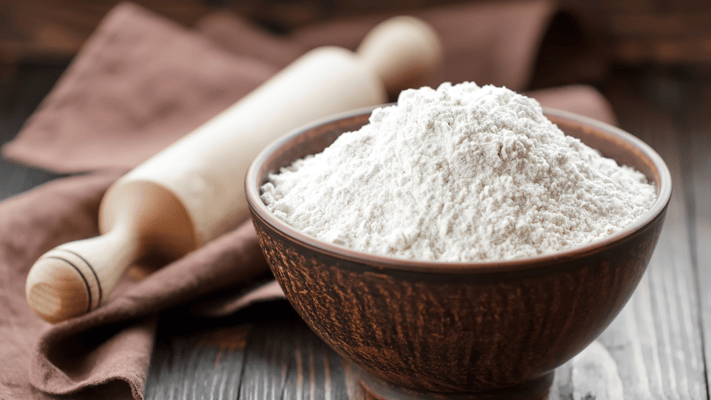Embracing India’s Flour Power

India, a country of vast climatic diversity and cultural richness,
has always found ways to adapt its food habits to local conditions.
From the dry, arid deserts of Rajasthan to the humid coasts of Kerala and the temperate plains of the Ganga basin, the Indian subcontinent offers a unique culinary tapestry woven through its choice of flours—or “atta”, as it’s commonly known.
Each region of India has traditionally consumed flour made from the grains best suited to its climate, soil, and agricultural patterns. And today, as conversations around sustainable eating, immunity, and preventive health grow louder, it’s time to revisit and hold the treasure trove of flours available in our own kitchens.
In most Indian households—
particularly in North, West, and Central India—whole wheat flour (atta) reigns supreme.
Used daily to make rotis, chapatis, and parathas, it is the backbone of the Indian flatbread culture. Wheat is adaptable to the temperate zones in India, availability, affordability, and nourishing profile have made it a default choice for households.
Wheat is rich in fiber, B vitamins, and iron, wheat provides steady energy and supports digestive health.
Regional Flours: Shaped By Climate And Tradition
I. Climate-Friendly Millet Flours as Superfoods
With India's push toward millet cultivation (declared as International Year of Millets in 2023), flours like bajra, jowar, and ragi are back in the spotlight.
• Bajra (Pearl Millet): Thrives in dry, arid zones like Rajasthan and Gujarat. High in iron and fiber—perfect for winter warmth.
• Jowar (Sorghum): Common in Maharashtra and Telangana, it’s rich in antioxidants and great for gluten-free diets.
• Ragi (Finger Millet): Grown in Karnataka and Tamil Nadu, known for its high calcium content—excellent for bone health.
II. Coastal Favourite Rice Flour
In the humid and water-rich South and East, rice flour is a staple, used for making dosa, idli, appam, and pithas. Being gluten-free and light, it suits the digestive needs in warmer climates.
III. The Winter Comfort Maize Flour (Makki ka Atta)
Loved in Punjab and northern hills, this coarse, yellow flour is ideal for making makki di roti, best enjoyed with sarson da saag. It’s warming, fibrous, and rich in antioxidants.
IV. Protein Powerhouses Besan (Gram Flour) & Sattu
Made from chana dal, besan is central to dishes like pakoras, kadhi, and sweets, while sattu, popular in Bihar and Jharkhand, is used in drinks and litti. Both are high in protein and aid digestion.
A Thoughtful Appeal to Fellow Indians
The great ancient wisdom of India has always recognized the healing power of food. Today, as lifestyle diseases rise and immunity becomes a buzzword, it's crucial we diversify our flours, much like we do our spices.
While wheat will remain central, including other flours—millets, pulses, and grains—in our daily meals can lead to better digestion, improved energy levels, stronger bones, and disease prevention.
India, a country of vast climatic diversity and cultural richness,
has always found ways to adapt its food habits to local conditions.
From the dry, arid deserts of Rajasthan to the humid coasts of Kerala and the temperate plains of the Ganga basin, the Indian subcontinent offers a unique culinary...
India, a country of vast climatic diversity and cultural richness,
has always found ways to adapt its food habits to local conditions.
From the dry, arid deserts of Rajasthan to the humid coasts of Kerala and the temperate plains of the Ganga basin, the Indian subcontinent offers a unique culinary tapestry woven through its choice of flours—or “atta”, as it’s commonly known.
Each region of India has traditionally consumed flour made from the grains best suited to its climate, soil, and agricultural patterns. And today, as conversations around sustainable eating, immunity, and preventive health grow louder, it’s time to revisit and hold the treasure trove of flours available in our own kitchens.
In most Indian households—
particularly in North, West, and Central India—whole wheat flour (atta) reigns supreme.
Used daily to make rotis, chapatis, and parathas, it is the backbone of the Indian flatbread culture. Wheat is adaptable to the temperate zones in India, availability, affordability, and nourishing profile have made it a default choice for households.
Wheat is rich in fiber, B vitamins, and iron, wheat provides steady energy and supports digestive health.
Regional Flours: Shaped By Climate And Tradition
I. Climate-Friendly Millet Flours as Superfoods
With India's push toward millet cultivation (declared as International Year of Millets in 2023), flours like bajra, jowar, and ragi are back in the spotlight.
• Bajra (Pearl Millet): Thrives in dry, arid zones like Rajasthan and Gujarat. High in iron and fiber—perfect for winter warmth.
• Jowar (Sorghum): Common in Maharashtra and Telangana, it’s rich in antioxidants and great for gluten-free diets.
• Ragi (Finger Millet): Grown in Karnataka and Tamil Nadu, known for its high calcium content—excellent for bone health.
II. Coastal Favourite Rice Flour
In the humid and water-rich South and East, rice flour is a staple, used for making dosa, idli, appam, and pithas. Being gluten-free and light, it suits the digestive needs in warmer climates.
III. The Winter Comfort Maize Flour (Makki ka Atta)
Loved in Punjab and northern hills, this coarse, yellow flour is ideal for making makki di roti, best enjoyed with sarson da saag. It’s warming, fibrous, and rich in antioxidants.
IV. Protein Powerhouses Besan (Gram Flour) & Sattu
Made from chana dal, besan is central to dishes like pakoras, kadhi, and sweets, while sattu, popular in Bihar and Jharkhand, is used in drinks and litti. Both are high in protein and aid digestion.
A Thoughtful Appeal to Fellow Indians
The great ancient wisdom of India has always recognized the healing power of food. Today, as lifestyle diseases rise and immunity becomes a buzzword, it's crucial we diversify our flours, much like we do our spices.
While wheat will remain central, including other flours—millets, pulses, and grains—in our daily meals can lead to better digestion, improved energy levels, stronger bones, and disease prevention.










Leave a Comment